A Highly Sensitive and Selective Nano-Fluorescent Probe for Ratiometric and Visual Detection of Oxytetracycline Benefiting from Dual Roles of Nitrogen-Doped Carbon Dots
Abstract
:1. Introduction
2. Materials and Methods
2.1. Materials and Structural Characterization
2.2. Preparation of NCDs
2.3. Ratiometric Detection of OTC
2.4. Assay of OTC in Real Samples
3. Results and Discussion
3.1. Synthesis and Characterization of NCDs
3.2. Fabrication of Ratiometric Fluorescence Probe for OTC Detection
3.3. Possible Sensing Mechanism of the Probe for OTC Detection
3.4. Optimization of Experimental Conditions
3.5. Ratiometric Detection of OTC
3.6. Assay of Real Samples
4. Conclusions
Supplementary Materials
Author Contributions
Funding
Data Availability Statement
Conflicts of Interest
References
- Chopra, I.; Roberts, M. Tetracycline antibiotics: Mode of action, applications, molecular biology, and epidemiology of bacterial resistance. Microbiol. Mol. Biol. Rev. 2001, 65, 232–260. [Google Scholar] [CrossRef] [PubMed] [Green Version]
- Naik, L.; Sharma, R.; Mann, B.; Lata, K.; Rajput, Y.S.; Surendra Nath, B. Rapid screening test for detection of oxytetracycline residues in milk using lateral flow assay. Food Chem. 2017, 219, 85–92. [Google Scholar] [CrossRef] [PubMed]
- de la Cruz, E.; Fournier, M.L.; García, F.; Molina, A.; Chavarría, G.; Alfaro, M.; Ramírez, F.; Rodríguez, C. Hazard prioritization and risk characterization of antibiotics in an irrigated Costa Rican region used for intensive crop, livestock and aquaculture farming. J. Environ. Biol. 2014, 35, 85. [Google Scholar]
- Fuoco, D. Classification framework and chemical biology of tetracycline-structure-based drugs. Antibiotics 2012, 1, 1. [Google Scholar] [CrossRef]
- Chatterjee, P.; Fleck, F. Mobilizing political will to contain antimicrobial resistance: The third part of our series on antimicrobial resistance looks at what governments are doing and what they can do next to combat this global threat. Bull. World Health Organ. 2011, 89, 168–170. [Google Scholar]
- Zhi, S.; Shen, S.; Zhou, J.; Ding, G.; Zhang, K. Systematic analysis of occurrence, density and ecological risks of 45 veterinary antibiotics: Focused on family livestock farms in Erhai Lake basin, Yunnan, China. Environ. Pollut. 2020, 267, 115539. [Google Scholar] [CrossRef] [PubMed]
- Santaeufemia, S.; Torres, E.; Mera, R.; Abalde, J. Bioremediation of oxytetracycline in seawater by living and dead biomass of the microalga Phaeodactylum tricornutum. J. Hazard. Mater. 2016, 320, 315–325. [Google Scholar] [CrossRef] [PubMed]
- Perez-Silva, I.; Rodriguez, J.A.; Teresa Ramirez-Silva, M.; Elena Paez-Hernandez, M. Determination of oxytetracycline in milk samples by polymer inclusion membrane separation coupled to high performance liquid chromatography. Anal. Chim. Acta 2012, 718, 42–46. [Google Scholar] [CrossRef]
- Wu, X.; Xu, Z.; Huang, Z.; Shao, C. Large volume sample stacking of cationic tetracycline antibiotics toward 10 ppb level analysis by capillary electrophoresis with UV detection. Electrophoresis 2016, 37, 2963–2969. [Google Scholar] [CrossRef]
- Blanchflower, W.J.; McCracken, R.J.; Haggan, A.S.; Kennedy, D.G. Confirmatory assay for the determination of tetracyline, oxytetracycline, chlortetracycline and its isomers in muscle and kidney using liquid chromatography-mass spectrometry. J. Chromatogr. B Biomed. Sci. Appl. 1997, 692, 351–360. [Google Scholar] [CrossRef]
- Widiastuti, R.; Anastasia, Y. Detection of oxytetracycline in broiler chicken meat marketed in several cities in java island using enzyme-linked immunosorbent assay (ELISA) method. J. Indonesian. Trop. Anim. 2015, 40, 52–58. [Google Scholar] [CrossRef] [Green Version]
- Birader, K.; Kumar, P.; Tammineni, Y.; Barla, J.A.; Reddy, S.; Suman, P. Colorimetric aptasensor for on-site detection of oxytetracycline antibiotic in milk. Food Chem. 2021, 356, 129659. [Google Scholar] [CrossRef]
- Wang, H.; Wang, Y.; Liu, S.; Yu, J.; Guo, Y.; Xu, Y.; Huang, J. Signal-on electrochemical detection of antibiotics at zeptomole level based on target-aptamer binding triggered multiple recycling amplification. Biosens. Bioelectron. 2016, 80, 471–476. [Google Scholar] [CrossRef] [PubMed]
- Han, S.; Yang, L.; Wen, Z.; Chu, S.; Wang, M.; Wang, Z.; Jiang, C. A dual-response ratiometric fluorescent sensor by europium-doped CdTe quantum dots for visual and colorimetric detection of tetracycline. J. Hazard. Mater. 2020, 398, 122894. [Google Scholar] [CrossRef] [PubMed]
- Jiang, R.; Lin, D.; Zhang, Q.; Li, L.; Yang, L. Multiplex chroma-response based fluorescent smartphone sensing platform for rapid and visual quantitative determination of antibiotic residues. Sensor. Actuat. B Chem. 2022, 350, 130902. [Google Scholar] [CrossRef]
- Lan, L.; Yao, Y.; Ping, J.; Ying, Y. Recent advances in nanomaterial-based biosensors for antibiotics detection. Biosens. Bioelectron. 2017, 91, 504–514. [Google Scholar] [CrossRef]
- Zhang, L.; Wang, Y.; Jia, L.; Bi, N.; Bie, H.; Chen, X.; Zhang, C.; Xu, J. Ultrasensitive and visual detection of tetracycline based on dual-recognition units constructed multicolor fluorescent nano-probe. J. Hazard. Mater. 2021, 409, 124935. [Google Scholar] [CrossRef]
- Xu, J.; Shen, X.; Jia, L.; Zhou, T.; Ma, T.; Xu, Z.; Cao, J.; Ge, Z.; Bi, N.; Zhu, T.; et al. A novel visual ratiometric fluorescent sensing platform for highly-sensitive visual detection of tetracyclines by a lanthanide- functionalized palygorskite nanomaterial. J. Hazard. Mater. 2018, 342, 158–165. [Google Scholar] [CrossRef]
- Tan, H.; Ma, C.; Song, Y.; Xu, F.; Chen, S.; Wang, L. Determination of tetracycline in milk by using nucleotide/lanthanide coordination polymer-based ternary complex. Biosens. Bioelectron. 2013, 50, 447–452. [Google Scholar] [CrossRef]
- Lim, S.Y.; Shen, W.; Gao, Z. Carbon quantum dots and their applications. Chem. Soc. Rev. 2015, 44, 362–381. [Google Scholar] [CrossRef]
- Liu, S.; Tian, J.; Wang, L.; Zhang, Y.; Qin, X.; Luo, Y.; Asiri, A.M.; Al-Youbi, A.O.; Sun, X. Hydrothermal treatment of grass: A low-cost, green route to nitrogen-doped, carbon-rich, photoluminescent polymer nanodots as an effective fluorescent sensing platform for label-free detection of Cu(II) ions. Adv. Mater. 2012, 24, 2037–2041. [Google Scholar] [CrossRef] [PubMed]
- Yang, L.; Zhao, H.; Liu, N.; Wang, W. A target analyte induced fluorescence band shift of piperazine modified carbon quantum dots: A specific visual detection method for oxytetracycline. Chem. Commun. 2019, 55, 12364–12367. [Google Scholar] [CrossRef] [PubMed]
- Fu, Y.; Huang, L.; Zhao, S.; Xing, X.; Lan, M.; Song, X. A carbon dot-based fluorometric probe for oxytetracycline detection utilizing a Forster resonance energy transfer mechanism. Spectrochim. Acta A 2021, 246, 118947. [Google Scholar] [CrossRef] [PubMed]
- Xu, Z.; Wang, Z.; Liu, M.; Yan, B.; Ren, X.; Gao, Z. Machine learning assisted dual-channel carbon quantum dots-based fluorescence sensor array for detection of tetracyclines. Spectrochim. Acta A 2020, 232, 118147. [Google Scholar] [CrossRef]
- Wang, T.; Mei, Q.; Tao, Z.; Wu, H.; Zhao, M.; Wang, S.; Liu, Y. A smartphone-integrated ratiometric fluorescence sensing platform for visual and quantitative point-of-care testing of tetracycline. Biosens. Bioelectron. 2020, 148, 111791. [Google Scholar] [CrossRef] [PubMed]
- Yang, K.; Jia, P.; Hou, J.; Bu, T.; Sun, X.; Liu, Y.; Wang, L. Innovative dual-emitting ratiometric fluorescence sensor for tetracyclines detection based on boron nitride quantum dots and europium ions. ACS Sustain. Chem. Eng. 2020, 8, 17185–17193. [Google Scholar] [CrossRef]
- Wang, Q.; Li, X.; Yang, K.; Zhao, S.; Zhu, S.; Wang, B.; Yi, J.; Zhang, Y.; Song, X.; Lan, M. Carbon dots and Eu3+ hybrid-based ratiometric fluorescent probe for oxytetracycline detection. Ind. Eng. Chem. Res. 2022, 61, 5825–5832. [Google Scholar] [CrossRef]
- Li, W.; Zhu, J.; Xie, G.; Ren, Y.; Zheng, Y.Q. Ratiometric system based on graphene quantum dots and Eu(3+) for selective detection of tetracyclines. Anal. Chim. Acta 2018, 1022, 131–137. [Google Scholar] [CrossRef]
- Sun, Y.Q.; Cheng, Y.; Yin, X.B. Dual-ligand lanthanide metal-organic framework for sensitive ratiometric fluorescence detection of hypochlorous acid. Anal. Chem. 2021, 93, 3559–3566. [Google Scholar] [CrossRef]
- Li, G.; Tong, C. Dual-functional lanthanide metal organic frameworks for visual and ultrasensitive ratiometric fluorescent detection of phosphate based on aggregation-induced energy transfer. Anal. Chim. Acta 2020, 1133, 11–19. [Google Scholar] [CrossRef]
- Wu, H.; Tong, C. Dual-emission fluorescent probe for the simultaneous detection of nitrite and mercury(II) in environmental water samples based on the Tb(3+)-modified carbon quantum dot/3-aminophenylboronic acid hybrid. Anal. Chem. 2020, 92, 8859–8866. [Google Scholar] [CrossRef]
- Jia, P.; Bu, T.; Sun, X.; Liu, Y.; Liu, J.; Wang, Q.; Shui, Y.; Guo, S.; Wang, L. A sensitive and selective approach for detection of tetracyclines using fluorescent molybdenum disulfide nanoplates. Food Chem. 2019, 297, 124969. [Google Scholar] [CrossRef]
- Qu, S.; Wang, X.; Lu, Q.; Liu, X.; Wang, L. A biocompatible fluorescent ink based on water-soluble luminescent carbon nanodots. Angew. Chem. Int. Ed. Engl. 2012, 51, 12215–12218. [Google Scholar] [CrossRef] [PubMed]
- Liu, W.; Xu, S.; Liang, R.; Wei, M.; Evans, D.G.; Duan, X. In situ synthesis of nitrogen-doped carbon dots in the interlayer region of a layered double hydroxide with tunable quantum yield. J. Mater. Chem. C 2017, 5, 3536–3541. [Google Scholar] [CrossRef]
- Wang, J.; Wang, C.F.; Chen, S. Amphiphilic egg-derived carbon dots: Rapid plasma fabrication, pyrolysis process, and multicolor printing patterns. Angew. Chem. Int. Ed. Engl. 2012, 51, 9297–9301. [Google Scholar] [CrossRef]
- Li, L.-L.; Ji, J.; Fei, R.; Wang, C.-Z.; Lu, Q.; Zhang, J.-R.; Jiang, L.-P.; Zhu, J.-J. A facile microwave avenue to electrochemiluminescent two-Color graphene quantum dots. Adv. Funct. Mater. 2012, 22, 2971–2979. [Google Scholar] [CrossRef]
- Wang, Y.; Yan, L.; Ji, G.; Wang, C.; Gu, H.; Luo, Q.; Chen, Q.; Chen, L.; Yang, Y.; Ma, C.Q.; et al. Synthesis of N,S-doped carbon quantum dots for use in organic solar cells as the ZnO modifier to eliminate the light-soaking effect. ACS Appl. Mater. Interfaces 2019, 11, 2243–2253. [Google Scholar] [CrossRef]
- Dong, Y.; Pang, H.; Yang, H.B.; Guo, C.; Shao, J.; Chi, Y.; Li, C.M.; Yu, T. Carbon-based dots co-doped with nitrogen and sulfur for high quantum yield and excitation-independent emission. Angew. Chem. Int. Ed. Engl. 2013, 52, 7800–7804. [Google Scholar] [CrossRef]
- Wu, Z.L.; Liu, Z.X.; Yuan, Y.H. Carbon dots: Materials, synthesis, properties and approaches to long-wavelength and multicolor emission. J. Mater. Chem. B 2017, 5, 3794–3809. [Google Scholar] [CrossRef]
- Zhu, S.; Song, Y.; Zhao, X.; Shao, J.; Zhang, J.; Yang, B. The photoluminescence mechanism in carbon dots (graphene quantum dots, carbon nanodots, and polymer dots): Current state and future perspective. Nano Res. 2015, 8, 355–381. [Google Scholar] [CrossRef]
- Zhao, C.X.; Zhang, X.P.; Shu, Y.; Wang, J.H. Europium-Pyridinedicarboxylate-Adenine Light-Up Fluorescence Nanoprobes for Selective Detection of Phosphate in Biological Fluids. ACS Appl. Mater. Interfaces 2020, 12, 22593–22600. [Google Scholar] [CrossRef] [PubMed]
- Wu, H.; Ling, Y.; Ju, S.; Chen, Y.; Xu, M.; Tang, Y. A smartphone-integrated light-up lanthanide fluorescent probe for the visual and ratiometric detection of total phosphorus in human urine and environmental water samples. Spectrochim. Acta A 2022, 279, 121360. [Google Scholar] [CrossRef] [PubMed]
- Ghorai, S.K.; Samanta, S.K.; Mukherjee, M.; Saha Sardar, P.; Ghosh, S. Tuning of “antenna effect” of Eu(III) in ternary systems in aqueous medium through binding with protein. Inorg. Chem. 2013, 52, 1476–1487. [Google Scholar] [CrossRef] [PubMed]
- Zhai, W.; Wang, C.; Yu, P.; Wang, Y.; Mao, L. Single-layer MnO2 nanosheets suppressed fluorescence of 7-hydroxycoumarin: Mechanistic study and application for sensitive sensing of ascorbic acid in vivo. Anal. Chem. 2014, 86, 12206–12213. [Google Scholar] [CrossRef] [PubMed]
- Lakowicz, J.R. Principles of Fluorescence Spectroscopy; Springer: Berlin/Heidelberg, Germany, 2006. [Google Scholar]
- Courrol, L.C.; Samad, R.E. Applications of europium tetracycline vomplex: A review. Curr. Pharm. Anal. 2008, 4, 238–248. [Google Scholar] [CrossRef]
- Li, C.; Zhu, L.; Yang, W.; He, X.; Zhao, S.; Zhang, X.; Tang, W.; Wang, J.; Yue, T.; Li, Z. Amino-functionalized Al-MOF for fluorescent detection of tetracyclines in milk. J. Agric. Food Chem. 2019, 67, 1277–1283. [Google Scholar] [CrossRef]
- Liu, Q.; Ning, D.; Li W., J.; Du X., M.; Wang, Q.; Li, Y.; Ruan W., J. Metal-organic framework-based fluorescent sensing of tetracycline-type antibiotics applicable to environmental and food analysis. Analyst 2019, 144, 1916–1922. [Google Scholar] [CrossRef]
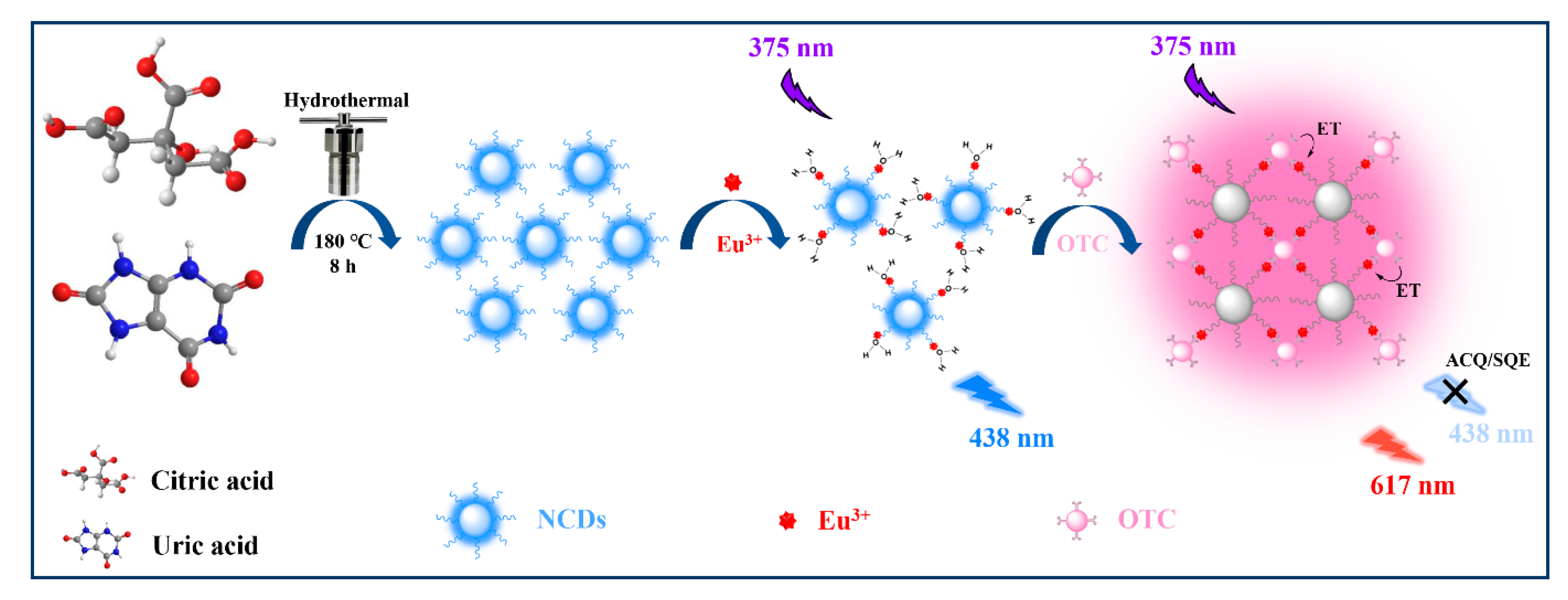

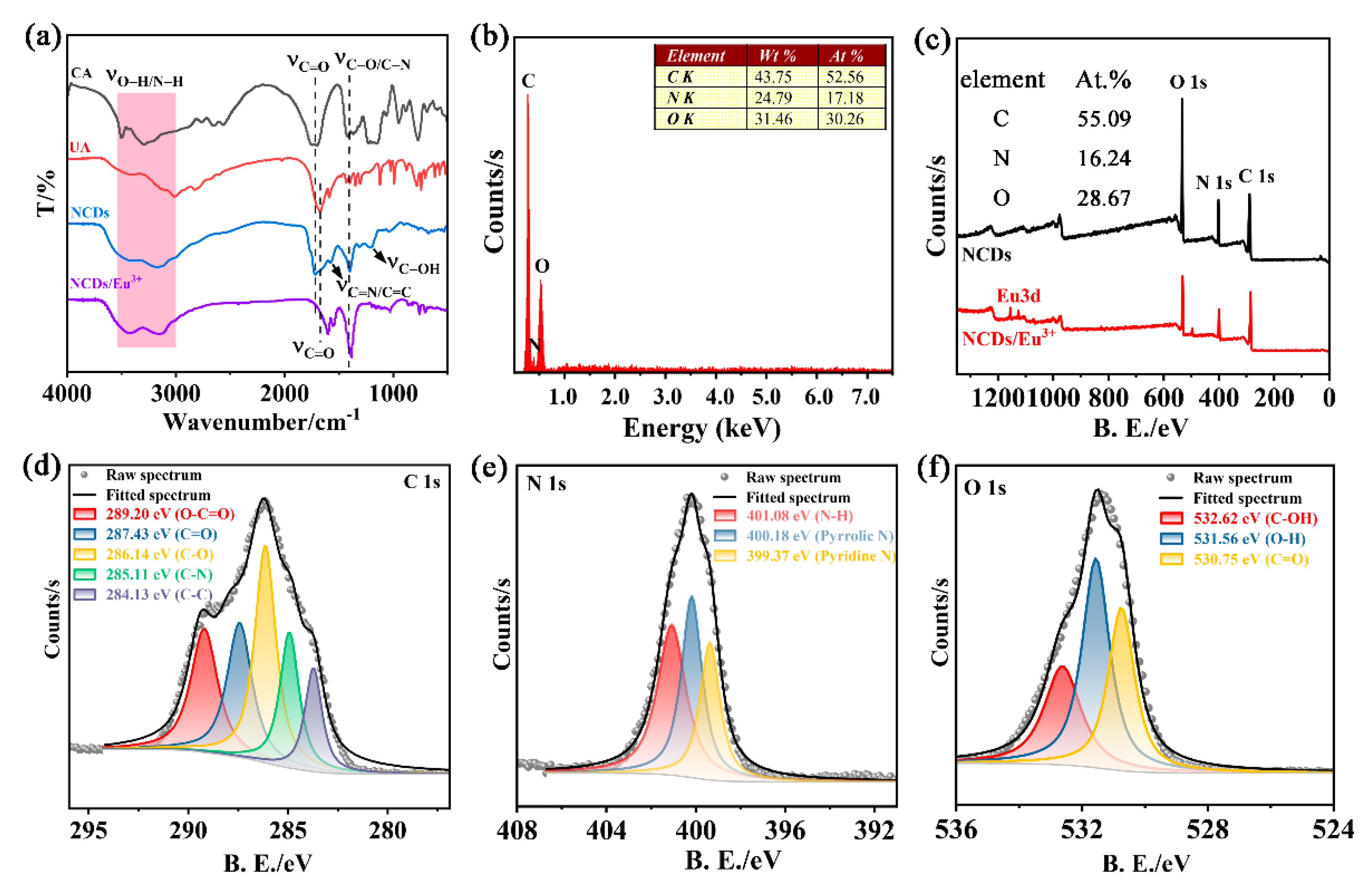
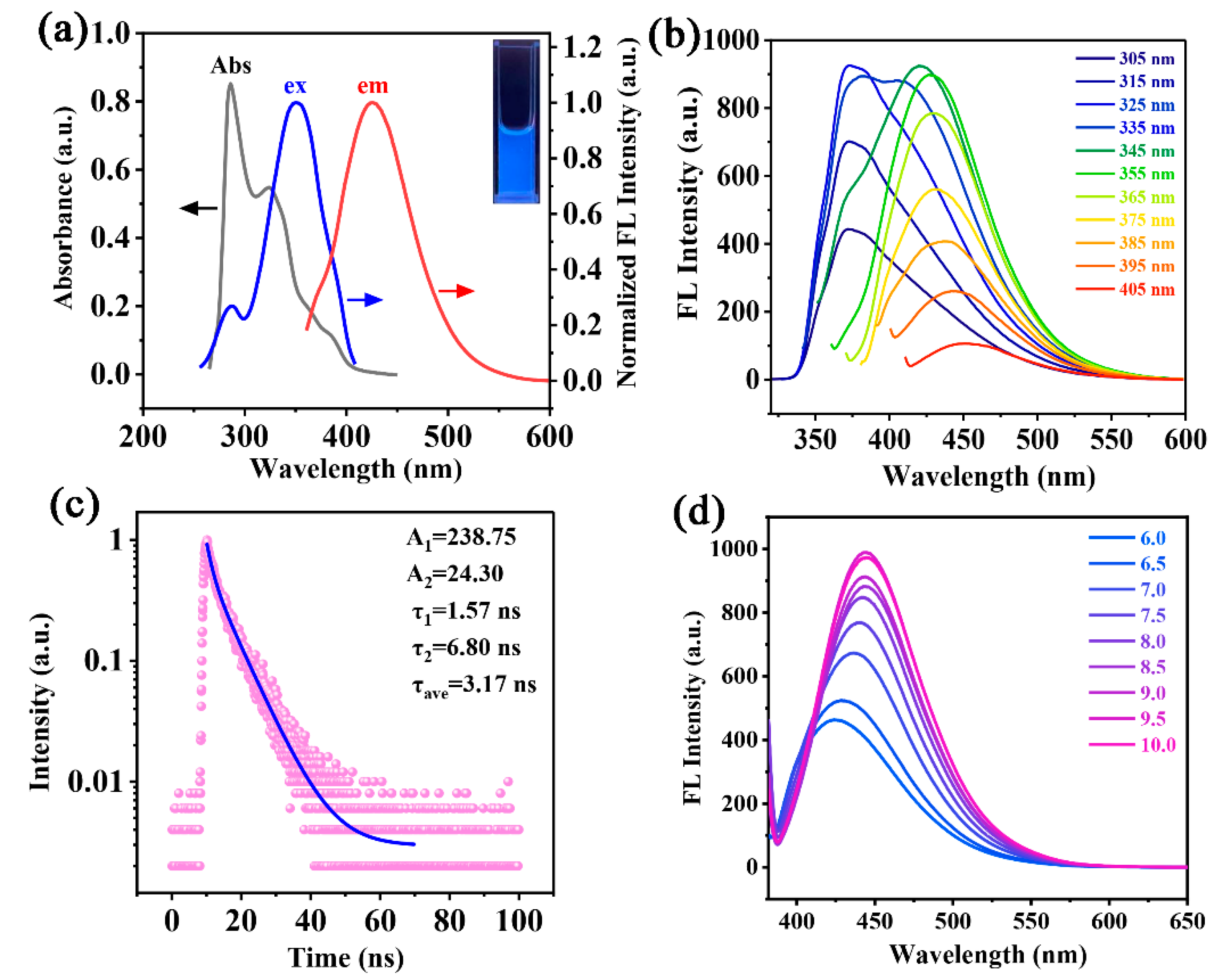
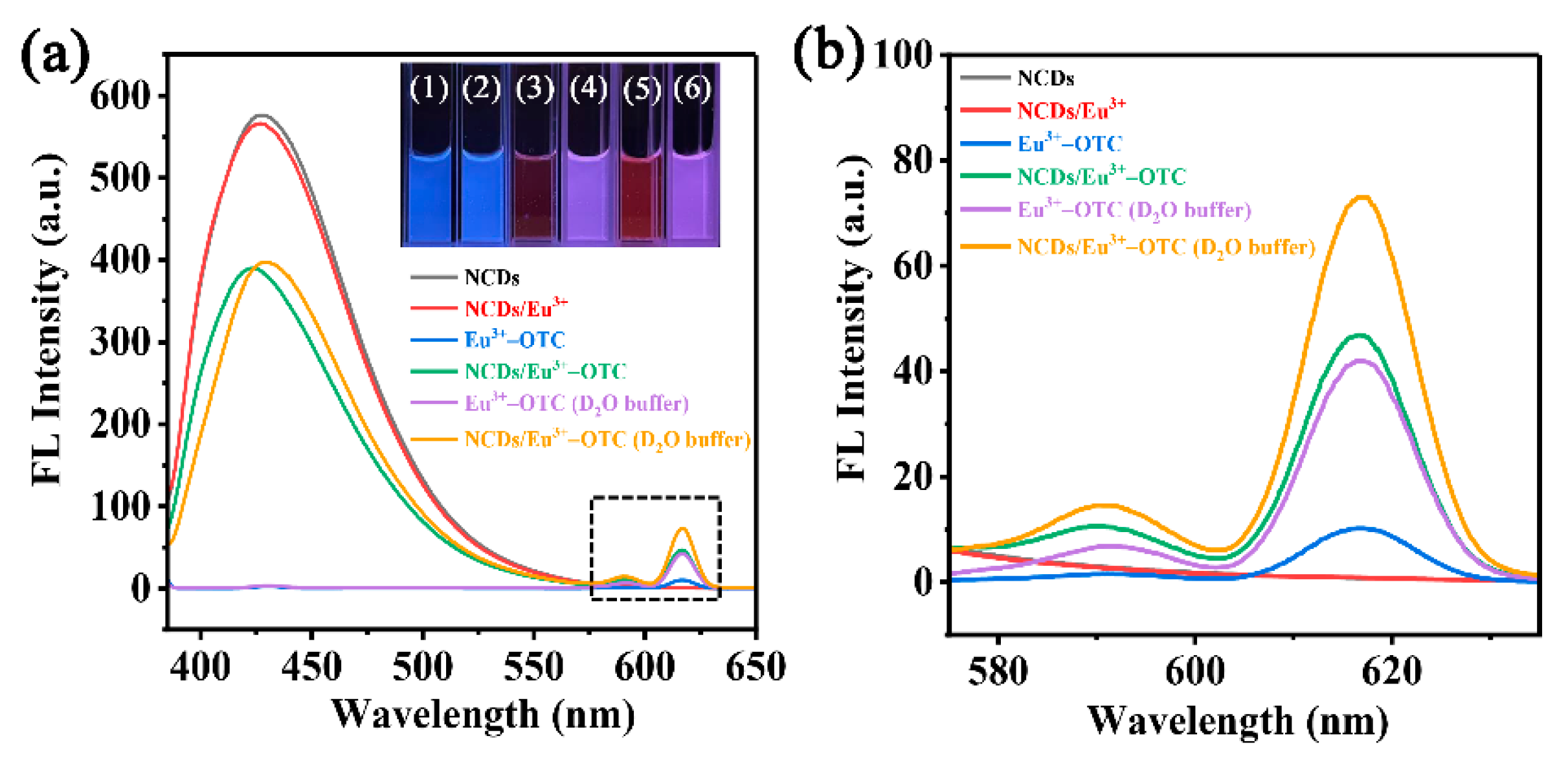

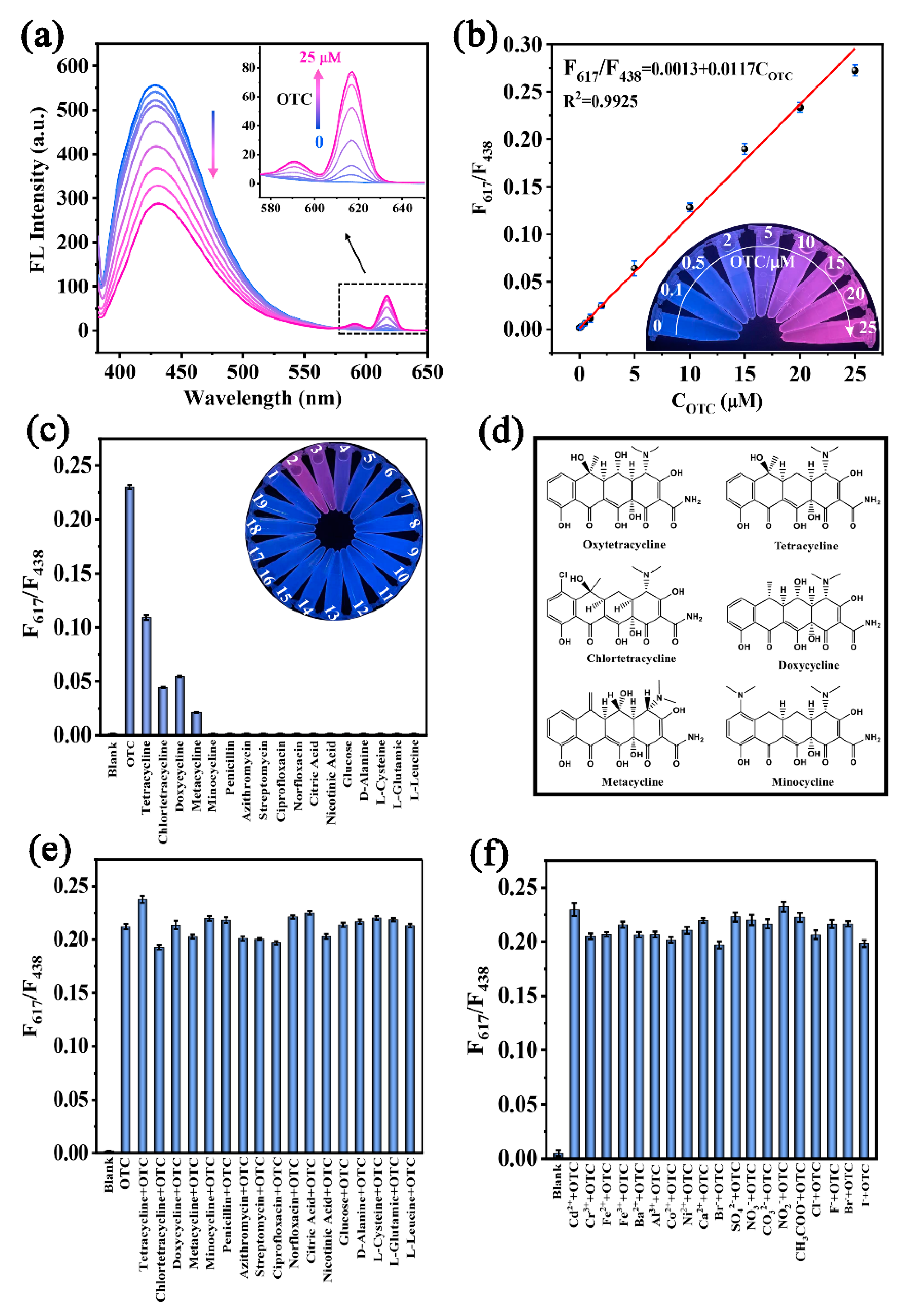
| Samples | Added (μM) | Detected (μM) | Recovery (%) | RSD (n = 3, %) |
|---|---|---|---|---|
| Tap water | 0 | ND a | − | − |
| 5 | 5.32 ± 0.13 | 106.4 | 2.4 | |
| 20 | 20.38 ± 0.45 | 101.9 | 2.2 | |
| Lake water | 0 | ND a | − | − |
| 5 | 5.02 ± 0.24 | 100.0 | 4.8 | |
| 20 | 19.76 ± 0.53 | 98.8 | 2.7 | |
| Milk | 0 | ND a | − | − |
| 5 | 4.72 ± 0.23 | 94.4 | 4.9 | |
| 20 | 19.20 ± 0.17 | 96.0 | 1.0 |
Publisher’s Note: MDPI stays neutral with regard to jurisdictional claims in published maps and institutional affiliations. |
© 2022 by the authors. Licensee MDPI, Basel, Switzerland. This article is an open access article distributed under the terms and conditions of the Creative Commons Attribution (CC BY) license (https://creativecommons.org/licenses/by/4.0/).
Share and Cite
Wu, H.; Xu, M.; Chen, Y.; Zhang, H.; Shen, Y.; Tang, Y. A Highly Sensitive and Selective Nano-Fluorescent Probe for Ratiometric and Visual Detection of Oxytetracycline Benefiting from Dual Roles of Nitrogen-Doped Carbon Dots. Nanomaterials 2022, 12, 4306. https://doi.org/10.3390/nano12234306
Wu H, Xu M, Chen Y, Zhang H, Shen Y, Tang Y. A Highly Sensitive and Selective Nano-Fluorescent Probe for Ratiometric and Visual Detection of Oxytetracycline Benefiting from Dual Roles of Nitrogen-Doped Carbon Dots. Nanomaterials. 2022; 12(23):4306. https://doi.org/10.3390/nano12234306
Chicago/Turabian StyleWu, Huifang, Mengqi Xu, Yubing Chen, Haoliang Zhang, Yongjun Shen, and Yanfeng Tang. 2022. "A Highly Sensitive and Selective Nano-Fluorescent Probe for Ratiometric and Visual Detection of Oxytetracycline Benefiting from Dual Roles of Nitrogen-Doped Carbon Dots" Nanomaterials 12, no. 23: 4306. https://doi.org/10.3390/nano12234306
APA StyleWu, H., Xu, M., Chen, Y., Zhang, H., Shen, Y., & Tang, Y. (2022). A Highly Sensitive and Selective Nano-Fluorescent Probe for Ratiometric and Visual Detection of Oxytetracycline Benefiting from Dual Roles of Nitrogen-Doped Carbon Dots. Nanomaterials, 12(23), 4306. https://doi.org/10.3390/nano12234306






